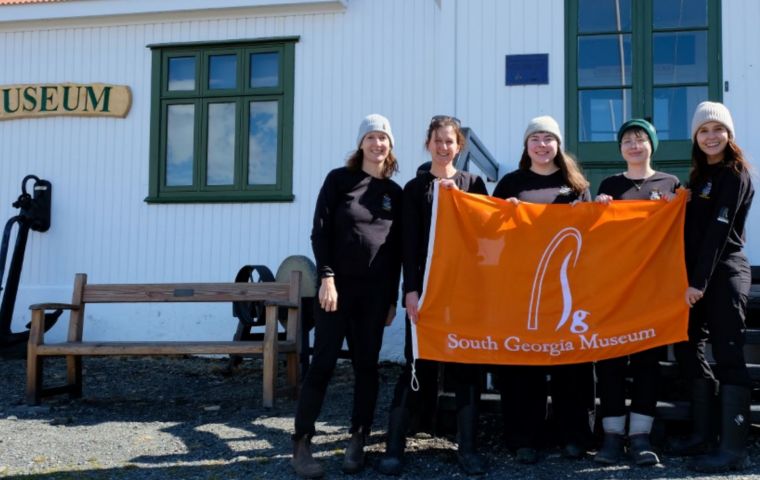MercoPress. South Atlantic News Agency
Female team, with descendants of whaler families, reopening the South Georgia Museum at Grytviken
 While museum assistant Helen is originally from Shetland, both her grandfathers and one great-grandfather were all whalers on SG throughout the 1930s to 1950s.
While museum assistant Helen is originally from Shetland, both her grandfathers and one great-grandfather were all whalers on SG throughout the 1930s to 1950s. An all-female team from Dundee in Scotland has travelled some 8,000 miles to South Georgia to help reopen the island's South Georgia Museum at Grytviken on time for the coming summer and cruise season.
The South Georgia Museum, situated some 1,000 miles from the Falkland Islands, and considered the world's most remote museum, will open for the first time since 2020 with the help of the small, all-female team.
South Georgia Heritage Trust (SGHT), based in Dundee, appointed a team to travel to South Georgia in the Southern Ocean. SGT run the museum on behalf of the government of South Georgia and South Sandwich Islands.
Trust director Deirdre Mitchell, from Dunfermline, is joined on the project by museum assistant Helen Balfour from Lerwick in Shetland and curatorial intern Aoife McKenna who recently graduated from the University of St Andrews. The team also includes curator Jayne Pierce from Bath, and senior museum assistant Lauren Elliott from Portsmouth.
Before leaving for South Georgia, director Deirdre lived in Inverness and previously spent time on the island as a former curatorial intern at the museum.
While museum assistant Helen is originally from Shetland, both her grandfathers and one great-grandfather were all whalers on the island throughout the 1930s to 1950s.
Helen’s grandfather James Balfour first visited South Georgia in 1952. After a decade of whaling, he was on board one of the last whale catcher vessels that worked out of Grytviken.
Her other grandfather Alan Leask started whaling as a 16-year-old and did two seasons, as did her great-grandfather Thomas Balfour twenty years before. Thomas had previously worked at a Salvesen whaling station closer to home at Olna, Shetland.
Helen will be following in their footsteps, as the now abandoned Grytviken whaling station is where the South Georgia Museum now stands.
South Georgia is famed for its iconic wildlife, including humpback whales, southern elephant seals, vast colonies of king penguins and an array of seabirds, and for its links with world-famous Antarctica explorer Sir Ernest Shackleton who is buried on the island.
This season, which runs from October to March, the museum is expected to welcome around 15,000 visitors.
Visitors to South Georgia will be able to see Shackleton’s original Crow’s Nest, a lookout barrel from his fourth and final voyage The Shackleton-Rowett Antarctic Expedition, also known as The Quest Expedition.
The Crow’s Nest is one of the last vestiges from Quest and will be the centerpiece of the South Georgia Museum’s current exhibition Shackleton’s Last Quest, which was launched to mark the centenary of Quest leaving London for South Georgia in 1921.
This will be the first time the Crow’s Nest has been on South Georgia since the expedition ship was there in 1922.




Top Comments
Disclaimer & comment rulesCommenting for this story is now closed.
If you have a Facebook account, become a fan and comment on our Facebook Page!